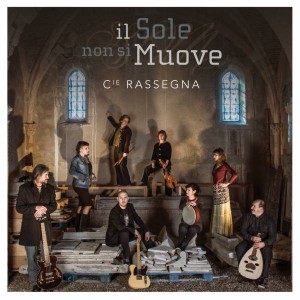 Hoe tijdloos kan muziek zijn? De groep Cie Rassegna nam op hun nieuwe album ‘il Sole non si Muove’ (De zon beweegt niet) stukken op uit Engeland en landen rond de Méditerranée, 16de eeuw. Moeiteloos vertaalt dit octet eeuwenoude composities naar het heden met musici uit Italië, Engeland, Frankrijk, Spanje, Portugal, Noord-Afrika en Armenië.
Hoe tijdloos kan muziek zijn? De groep Cie Rassegna nam op hun nieuwe album ‘il Sole non si Muove’ (De zon beweegt niet) stukken op uit Engeland en landen rond de Méditerranée, 16de eeuw. Moeiteloos vertaalt dit octet eeuwenoude composities naar het heden met musici uit Italië, Engeland, Frankrijk, Spanje, Portugal, Noord-Afrika en Armenië.
English version below
Zo’n 17 jaar geleden werd de groep Cie Rassegna opgericht in Marseille. Een gezelschap dat zich richt op het uitvoeren van wereldlijke liederen uit de 16de eeuw uit Engeland en landen rond de Middellandse Zee. Dat doen ze op zowel ‘oude’ als ‘nieuwe‘ instrumenten; op zowel de ûd (Arabische luit), viola da Gamba of kaval (fluit) als ook de elektrische (bas)gitaar en keyboards. Hiermee slaat de groep een brug tussen het verleden en heden met een accent op de authenticiteit van de muziek, met de nadruk op de oorspronkelijke uitvoeringspraktijk uit de 16de eeuw. Alle stukken worden gespeeld in verschillende bezettingen waarbij de ene keer de nadruk ligt op de Arabische signatuur zoals in ‘Saloumi‘ dan weer op de Engelse zoals in de ballad ‘Flow my tears’ waarbij de elektrische gitaar prachtig mengt met de viola da Gamba, aangevuld met de ney (fluit). Een unieke combinatie komen we ook tegen in ‘A pollish vilanell‘, een prachtig instrumentaal lied, een voorloper van het Napolitaanse lied. Erg mooi is de samenzang van de zangeressen Carien Lotta en Sylvie Paz. Twee heldere stemmen die fraai mengen. De wah-wah/fuzz gitaar, ney, basgitaar en gesproken woord zorgen voor een psychedelisch effect in ‘The three ravens‘ dat weer een heel ander Cie Rassegna laat horen. Gezongen wordt er in het Engels, Arabisch, Spaans en in het Frans zoals in ‘Ode sur la misere et la pauvrete‘, een lied uit de Provence gezongen door leider Bruno Allary. Elk lied op ‘il Sole non si Muove’ is een avontuurlijk miniatuur waar de begeleiding fraai is aangepast aan de sensitiviteit van de muziek. Dat is niet alleen knap gedaan maar ook nog eens goed gelukt waarmee maar weer eens is aangetoond hoe tijdloos muziek kan zijn!
English version
How timeless is music? The group Cie Rassegna recorded on their new album ‘il sole non si Muove‘ (The sun does not move) pieces from England and countries of the Mediterranean, 16th century . Effortlessly this octet translates ancient compositions to the present day with musicians from Italy, England, France, Spain, Portugal, North Africa and Armenia.
Some 17 years ago the group Cie Rassegna was founded in Marseille. An ensemble that focuses their performance on secular songs from the 16th century from England and countries around the Mediterranean. They use both ‘old‘ and ‘new‘ instruments; like the ud (Arabic lute), viola da Gamba or kaval (flute) as well as electrical (bass) guitar and keyboards. This group built a bridge between the past and present with an emphasis on the authenticity of the music, with an emphasis on the original performance practice of the 16th century. All the pieces are played in various combinations where one time the focus is on the Arabian signature as in ‘Saloumi‘ then the English, as in the ballad ‘Flow my tears‘ where the electric guitar blends beautifully with the viola da Gamba, supplemented the ney (flute). An unique combination can also be seen in ‘A Pollish vilanell‘, a beautiful instrumental song, a precursor of the Neapolitan song. Very beautiful are the voices of Carien Lotta and Sylvie Paz, which blend excellent. The wah-wah / fuzz guitar, ney, bass guitar and spoken word create a psychedelic effect in ‘The three ravens‘ which shows us a different Cie Rassegna. Lyrics are sung in English, Arabic, Spanish and French as the ‘Ode sur la misery et la pauvreté’, a song from Provence sung by leader Bruno Allary. Each song on “Il Sole non si Muove‘ is an adventurous miniature in which the music is beautifully adapted to the sensitivity of the music. It shows the listener how timeless his music can be, very well done!
- Cie Rassegna: ‘il Sole non si Muove’ (Buda Musique/Xango)
© Mattie Poels.

Geen reacties